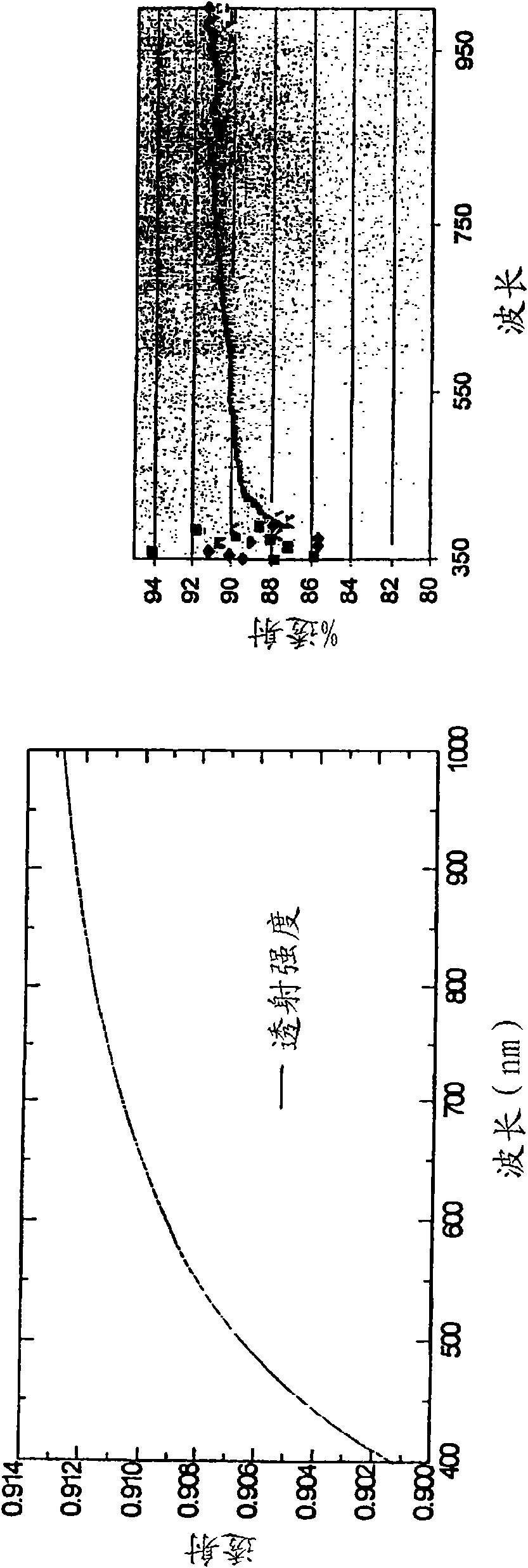Polymeric composition
A composition, polymer technology, used in the field of plastic lenses, optical polymer compositions and the preparation of such compositions
- Summary
- Abstract
- Description
- Claims
- Application Information
AI Technical Summary
Problems solved by technology
Method used
Image
Examples
Embodiment 1
[0142] Dye concentrates were prepared by mixing and grinding the materials listed in Table 14 below:
[0143] Table 14
[0144] Material:
[0145] Additive compositions were prepared by mixing and grinding the above dye concentrates with the materials listed in Table 15:
[0146] Table 15
[0147] Material:
[0148] High molecular weight, low volatility primary antioxidant;
[0149] The polymer compositions shown in Table 16 use APEC TP-0277 polycarbonate resin pellets were prepared with the additive compositions shown in Table 15. The resin pellets were dried in a vacuum oven at 135°C for 4 hours until the water content was below 0.01 wt%. The resin pellets were heated to 135°C, and then the additive composition was added to the resin pellets in a tumbling mixer at a weight ratio of 0.6:99.4. The resin pellets and additive composition were tumble blended for 5 minutes or until the additive composition melted onto and coated the resin p...
Embodiment 2
[0183] The polymer composition of Example 1 was molded into strips of size 1 x 14 x 7 mm. The molded sample was heated up to 260° C. at a rate of 2° C. / min, and Tg was measured by DMTA (Dynamic Mechanical Thermal Analysis) under a load of 1 Hz. This test showed that the molded bars were able to withstand short-term temperature peaks up to 260°C and higher without deformation. see results image 3 .
Embodiment 3
[0185] Four polymer compositions 1-4 having the formulations described in Table 17 were injection molded to prepare LED lenses as described below. The high-temperature optical thermoplastic soldering reflow study was carried out on the LED lens, and the results are listed in Table 18.
[0186] Table 17
[0187]
[0188]
[0189] Table 18
[0190] Composition #1
[0191] (Simulation & Actual Soldering Reflow Temperature Study)
[0192] SR = solder reflow A = anneal R rapid anneal
[0193] S = slow annealed U = no annealed
[0194] test
[0195] / R
[0196] / R
[0197] 32.
[0198] R = rapid annealed part at 217°C for 17 min. S = Slowly annealed parts, ramp over 30 minute intervals, hold at 215°C for 30 minutes, then cool for 30 minutes.
PUM
| Property | Measurement | Unit |
|---|---|---|
| Refractive index | aaaaa | aaaaa |
Abstract
Description
Claims
Application Information
 Login to View More
Login to View More - R&D
- Intellectual Property
- Life Sciences
- Materials
- Tech Scout
- Unparalleled Data Quality
- Higher Quality Content
- 60% Fewer Hallucinations
Browse by: Latest US Patents, China's latest patents, Technical Efficacy Thesaurus, Application Domain, Technology Topic, Popular Technical Reports.
© 2025 PatSnap. All rights reserved.Legal|Privacy policy|Modern Slavery Act Transparency Statement|Sitemap|About US| Contact US: help@patsnap.com



